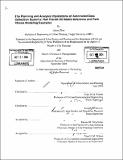| dc.contributor.advisor | Nigel H.M. Wilson and Joseph Ferreira, Jr. | en_US |
| dc.contributor.author | Zhao, Jinhua, 1977- | en_US |
| dc.contributor.other | Massachusetts Institute of Technology. Dept. of Urban Studies and Planning. | en_US |
| dc.date.accessioned | 2005-09-27T18:09:19Z | |
| dc.date.available | 2005-09-27T18:09:19Z | |
| dc.date.copyright | 2004 | en_US |
| dc.date.issued | 2004 | en_US |
| dc.identifier.uri | http://hdl.handle.net/1721.1/28752 | |
| dc.description | Thesis (M.C.P.)--Massachusetts Institute of Technology, Dept. of Urban Studies and Planning; and, (S.M. in Transportation)--Massachusetts Institute of Technology, Dept. of Civil and Environmental Engineering, 2004. | en_US |
| dc.description | Includes bibliographical references (leaf 124). | en_US |
| dc.description.abstract | (cont.) by presenting two case studies both in the context of the Chicago Transit Authority. One study proposes an enhanced method of inferring the rail trip OD matrix from an origin-only AFC system to replace the routine passenger survey. The proposed algorithm takes advantage of the pattern of a person's consecutive transit trip segments. In particular the study examines the rail-to-bus case (which is ignored by prior studies) by integrating AFC and AVL data and utilizing GIS and DBMS technologies. A software tool is developed to facilitate the implementation of the algorithm. The other study is of rail path choice, which employs the Logit and Mixed Logit models to examine revealed public transit riders' travel behavior based on the inferred OD matrix and the transit network attributes. This study is based on two data sources: the rail trip OD matrix inferred in the first case study and the attributes of alternative paths calculated from a network representation in Trans CAD. This study demonstrates that a rigorous traveler behavior analysis can be performed based on the data source from ADC systems. Both cases illustrate the potential as well as the difficulty of utilizing these systems and more importantly demonstrate that at relatively low marginal cost, ADC systems can provide transit agencies with a rich information source to support decision making. The impact of a new data collection strategy ... | en_US |
| dc.description.abstract | Transit agencies in U.S. are on the brink of a major change in the way they make many critical planning decisions. Until recently transit agencies have lacked the data and the analysis techniques needed to make informed decisions in both long-term planning and day-to-day operations. Now these agencies are entering an era in which a large volume of raw data will be available due to the implementation of ITS technology including Automated Data Collection systems (ADC), such as Automated Fare Collection systems (AFC), Automated Vehicle Location systems (AVL), and Automatic Passenger Counting systems (APC). Automated Data Collection systems have distinct advantages over the traditional data collection methods: large temporal and spatial coverage, continuous data flow and currency, low marginal cost, accuracy, automatic collection and central storage, etc. Thanks to these unique features, there exists a great potential for ADC systems to be used to support decision-making in transit agencies. However, effectively utilizing ADC systems data is not straightforward. Several examples are given to illustrate that there is a critical gap between what ADC systems directly offer and what is needed practically in public transit agencies' decision-making practice. Meanwhile, the framework of data processing and analysis is not readily available, and transit agencies generally lack needed qualified staff. As a consequence, these data sources have not yet been effectively utilized in practice. A strong foundation of ADC data manipulation, analysis methodologies and techniques with support of advanced technologies such DBMS and GIS is required before the full value of the new data source can be exploited. This research is an initial attempt to lay out such a framework | en_US |
| dc.description.statementofresponsibility | by Jinhua Zhao. | en_US |
| dc.format.extent | 124 leaves | en_US |
| dc.format.extent | 6267605 bytes | |
| dc.format.extent | 6281675 bytes | |
| dc.format.mimetype | application/pdf | |
| dc.format.mimetype | application/pdf | |
| dc.language.iso | en_US | |
| dc.publisher | Massachusetts Institute of Technology | en_US |
| dc.rights | M.I.T. theses are protected by copyright. They may be viewed from this source for any purpose, but reproduction or distribution in any format is prohibited without written permission. See provided URL for inquiries about permission. | en_US |
| dc.rights.uri | http://dspace.mit.edu/handle/1721.1/7582 | |
| dc.subject | Civil and Environmental Engineering. | en_US |
| dc.subject | Urban Studies and Planning. | en_US |
| dc.title | The planning and analysis implications of automated data collection systems : rail transit OD matrix inference and path choice modeling examples | en_US |
| dc.type | Thesis | en_US |
| dc.description.degree | S.M.in Transportation | en_US |
| dc.description.degree | M.C.P. | en_US |
| dc.contributor.department | Massachusetts Institute of Technology. Department of Civil and Environmental Engineering | |
| dc.contributor.department | Massachusetts Institute of Technology. Department of Urban Studies and Planning | |
| dc.identifier.oclc | 59820922 | en_US |
